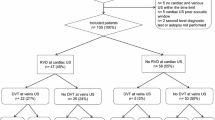Abstract
Noninvasive tests for deep venous thrombosis (DVT) are helpful in evaluating patients with suspected pulmonary embolism (PE) who have non-high-probability ventilation/perfusion (V/Q) lung scans. Based on the enthusiasm for these noninvasive tests, venous duplex imaging (VDI) has evolved as the initial screening test for patients with clinically suspected PE in some centers. This study evaluates the utility of VDI as the initial test in a diagnostic algorithm for patients with suspected PE. A total of 306 consecutive patients who underwent VDI as the initial screening test for clinically suspected PE during the past 24 months were reviewed; 121 patients were subsequently evaluated with V/Q scans and 20 underwent pulmonary arteriography. VDI demonstrated DVT in 10% (23/216), with 7% (22/306) having proximal DVT and 3% (9/306) having isolated calf DVT. In 25 patients with unilateral leg symptoms, DVT was found in 40% (10/25); however, among the 281 without unilateral leg symptoms, results of VDI were abnormal in only 5% (15/281). V/Q scans were obtained in 40% (121/306), with only 16% (19/121) of scans showing a high probability of PE. DVT was found in 25% (5/19) of patients with high-probability V/Q scans and in 25% (26/102) with non-high-probability scans. In patients with clinically suspected PE the incidence of detectable infrainguinal DVT is low. VDI appears to be a reasonable initial screening test in patients with clinically suspected PE and unilateral leg symptoms. However, in patients without unilateral leg symptoms, the diagnostic yield is low and an alternative diagnostic approach appears justified.
Similar content being viewed by others
References
PIOPED Investigators. Value of ventilation/perfusion scan in acute pulmonary embolism. JAMA 1990;263:2753–2795.
Greenspan RH, Ravin CE, Polansky SM, et al. Accuracy of chest radiography in the diagnosis of pulmonary embolism. Invest Radiol 1982;17:539–543.
Benotti JR, Ockene IS, Alpert JS, et al. Pulmonary embolism. Chest 1983;84:669–678.
Stein PD, Saltzman HA, Weg JG. Clinical characteristics of patients with acute pulmonary embolism. Am J Cardiol 1991;68:1723–1724.
Stein PD, Terin ML, Hales CA, et al. Clinical laboratory, roentgenographic and electrocardiographic findings in patients with acute pulmonary embolism and no pre-existing cardiac or pulmonary disease. Chest 1991;100:598–603.
Hull RD, Raskob GE, Coates G, et al. A new noninvasive management strategy for patients with suspected pulmonary embolism. Arch Intern Med 1989;149:2549–2555.
Quinn MF, Lundell CJ, Klotz TA, et al. Reliability of selective pulmonary arteriography in the diagnosis of pulmonary embolism. AJR 1987;149:469–471.
Bynum LJ, Wilson JE, Christansen EE, et al. Radiographic techniques for balloon-occlusion pulmonary angiography. Radiology 1979;133:518–520.
Hull RD, Hirsh J, Carter CJ, et al. Pulmonary angiography, ventilation lung scanning, and venography for clinically suspected pulmonary embolism with abnormal perfusion lung scan. Ann Intern Med 1983;98:891–899.
Hull RD, Raskob GE, Ginsburg JS, et al. A noninvasive strategy for the treatment of patients with suspected pulmonary embolism. Arch Intern Med 1994;154:289–297.
Comerota AJ, Katz ML, Hashemi HA. Venous duplex imaging for the diagnosis of deep vein thrombosis. Thromb Haemost 1993;23(Suppl 1):61–71.
Killewich LA, Bedford GR, Beach KW, et al. Diagnosis of deep vein thrombosis. A prospective study comparing duplex scanning to contrast venography. Circulation 1989;79:810–814.
Grollman JH, Gyepes MT, Helmer E. Transfemoral selective bilateral pulmonary angiography with a pulmonary-seeking catheter. Radiology 1970;96:202–204.
Dalen JE, Brooks HL, Johnson LW. Pulmonary angiography in acute pulmonary embolism: Indications, techniques, and results in 367 patients. Am Heart J 1971;81:175–185.
Killewich LA, Nunnelee J, Auer AI. Value of lower extremity venous duplex examination in the diagnosis of pulmonary embolism. J Vasc Surg 1993;17:934–939.
Hull RD, Raskob GE, Hirsh J, et al. Continuous heparin compared with intermittent subcutaneous heparin in the initial treat of proximal-vein thrombosis. N Engl J Med 1986;315:1109–1114.
Author information
Authors and Affiliations
Additional information
Supported in part by NIH grant 1 K07HL02658-01.
About this article
Cite this article
Eze, A.R., Comerota, A.J., Kerr, R.P. et al. Is venous duplex imaging an appropriate initial screening test for patients with suspected pulmonary embolism?. Annals of Vascular Surgery 10, 220–223 (1996). https://doi.org/10.1007/BF02001885
Issue Date:
DOI: https://doi.org/10.1007/BF02001885




